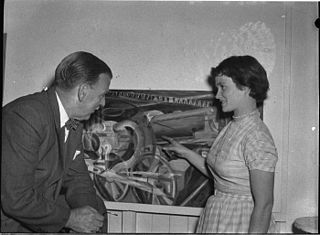
The Archibald Prize is an Australian portraiture art prize for painting, generally seen as the most prestigious portrait prize in Australia. It was first awarded in 1921 after the receipt of a bequest from J. F. Archibald, the editor of The Bulletin who died in 1919. It is administered by the trustees of the Art Gallery of New South Wales and awarded for "the best portrait, preferentially of some man or woman distinguished in Art, Letters, Science or Politics, painted by an artist resident in Australia during the twelve months preceding the date fixed by the trustees for sending in the pictures". The Archibald Prize has been awarded annually since 1921 and since July 2015 the prize has been AU$100,000.

Sir William Dobell was an Australian portrait and landscape artist of the 20th century. Dobell won the Archibald Prize, Australia's premier award for portrait artists on three occasions. The Dobell Prize is named in his honour.

John Henry Olsen AO OBE was an Australian artist and winner of the 2005 Archibald Prize. Olsen's primary subject of work was landscape.
The Sir John Sulman Prize is one of Australia's longest-running art prizes, having been established in 1936.
The Wynne Prize is an Australian landscape painting or figure sculpture art prize. As one of Australia's longest-running art prizes, it was established in 1897 from the bequest of Richard Wynne. Now held concurrently with the Sir John Sulman Prize and the Archibald Prize at the Art Gallery of New South Wales in Sydney.

The Dobell Drawing Prize is a biennial drawing prize and exhibition, held by the National Art School in association with the Sir William Dobell Art Foundation.The prize is an open call to all artists and aims to explore the enduring importance of drawing and the breadth and dynamism of contemporary approaches to drawing.
Nicholas Harding was a British-born Australian artist, known for his paintings, in particular portraits.
Kevin Connor, Australian artist who won the Archibald Prize twice; in 1975 for The Hon Sir Frank Kitto, KBE, and in 1977 for Robert Klippel. He won the Sulman Prize in 1991/92 with Najaf (Iraq) June 1991 and again in 1997 with The Man with itchy fingers and other figures Gare du Nord.
Art, Life, and the other thing is an Archibald Prize-winning 1978 painting by Australian artist Brett Whiteley which combines three different media in a triptych.
Graham Fransella is an Australian figurative and abstract painter.

Sam Leach is an Australian contemporary artist. He was born in Adelaide, South Australia. Leach worked for many years in the Australian Tax Office after completion of a degree in Economics. He also completed a Diploma of Art, Bachelor of Fine Art degree and a Master of Fine Art degree at RMIT in Melbourne, Victoria. Leach currently resides in Melbourne. Leach's work has been exhibited in several museum shows including "Optimism" at the Queensland Art Gallery and "Neo Goth" at the University of Queensland Art Museum in 2008, in 2009 "the Shilo Project" at the Ian Potter Museum of Art and "Horror Come Darkness" at the Macquarie University Art Gallery and "Still" at Hawkesbury Regional Gallery in 2010. His work is held in public collections of regional galleries of Geelong, Gold Coast, Coffs Harbour, Newcastle and Gippsland and the collections of La Trobe University and the University of Queensland.
Peter Sharp is an Australian artist who works predominantly in drawing.
Vladimir Meškėnas was an Australian expressionist painter and portraitist in oil and pastel, who has been a frequent Archibald Prize finalist.

Michael Kmit was a Ukrainian painter who spent twenty-five years in Australia. He is notable for introducing a neo-Byzantine style of painting to Australia, and winning a number of major Australian art prizes including the Blake Prize (1952) and the Sulman Prize. In 1969 the Australian artist and art critic James Gleeson described Kmit as "one of the most sumptuous colourists of our time".
Carlos Barrios is a Salvadoran-Australian artist.

Tim Storrier AM is an Australian artist who won the 2012 Doug Moran National Portrait Prize with The Lunar Savant, a portrait of fellow artist McLean Edwards.
Aida Tomescu is an Australian contemporary artist who is known for her abstract paintings, collages, drawings and prints. Tomescu is a winner of the Dobell Prize for Drawing, the Wynne Prize for Landscape and the Sir John Sulman Prize, by the Art Gallery of New South Wales.
The Wedderburn artistic community is an informal group of Australian contemporary artists based around Wedderburn, New South Wales, on Sydney sandstone bushland about 60 kilometres south of Sydney, close to the Georges River. Artists based around Wedderburn include Elisabeth Cummings, Roy Jackson, John Peart, David Hawkes, Suzanne Archer, David Fairbairn, Michael Bright and others. Artists associated with the group have won many major Australian art prizes, including the Wynne Prize, the Sir John Sulman Prize, the Doug Moran National Portrait Prize, the Dobell Prize for Drawing, and the Fleurieu Art Prize.

Lionel Hornibrook Jago (1882–1953) was an Australian artist active between 1910 and 1950.
Cameron Kingsley Hayes, known as Cameron Hayes, is an Australian artist specialising in large scale allegorical oil paintings in a figurative style. His paintings have been selected for numerous prestigious Australian art prizes including The Blake Prize, Moet and Chandon Fellowship and the Sir John Sulman Art Prize at the Art Gallery of New South Wales.















